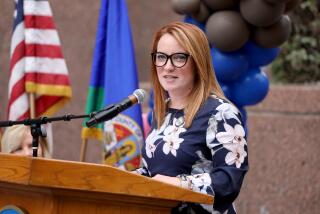Officials Prepare for Welfare Shift
Gearing up for the eventual overhaul of the state’s welfare system, Ventura County officials are preparing to carry out a range of state-mandated changes to public assistance programs while working to resurrect an ambitious plan to mend the county’s safety net for the poor.
Starting Jan. 1, about 30,000 Ventura County welfare recipients will be hit with a 4.9% cut in monthly assistance payments, the first step in implementing a backlog of changes signed into state law but stalled until recently by the lack of federal welfare reform.
The cut in Aid to Families with Dependent Children payments will reduce the monthly check for a family of three by about $29, to $565. And for the last six months of the fiscal year ending June 30, that move will save taxpayers an estimated $1.5 million in Ventura County alone.
Later next year, the county will also press forward with other changes, including a plan to prevent welfare mothers from collecting more money when they have more children, and a move to restrict new California residents to an aid payment no greater than their previous state of residence for the first 12 months they are here.
Taken together, officials say, the changes usher in a new era for California’s welfare system, signaling a fundamental shift in responsibility for welfare design from the federal government to the states, and perhaps even to the counties.
“For recipients in Ventura County, they won’t see any difference initially,” said Helen Reburn, deputy director of the county’s Public Social Services Agency. “But there’s no doubt that major changes are on the way.”
Anticipating those changes, officials are working to revive legislation--written by state Sen. Cathie Wright (R-Simi Valley)--that would allow Ventura County to restructure its public assistance programs.
Despite unanimous legislative support, Gov. Pete Wilson vetoed a bill in October that would have cleared the way for the county to try the new approach, citing conflicts between the local program and a landmark federal welfare reform package signed by President Clinton two months earlier.
But with welfare reform now barreling forward at the state level, county leaders are once again holding up that piece of legislation as an ideal way to revamp the current system of public aid.
In fact, Wright said she plans to reintroduce at least a version of Ventura County’s welfare reform bill in the Legislature in December.
“Since the veto, both my staff and staff from Ventura County have been working diligently with the department of social services,” Wright said. “There is still a lot of value in the plan that Ventura County has put together.”
Under that proposal, the county would create a three-year demonstration project that for the first time would combine money and staffing for welfare and return-to-work programs that have operated separately in the past.
It would also give county officials more control over how they spend welfare dollars and manage assistance programs. There are about 30,000 AFDC recipients locally, and about 42,000 people receive food stamps.
At the heart of the effort would be a push to funnel nearly all recipients of public aid into the workplace, with the hope that for most a payroll check would eventually replace their welfare checks.
Even without the state legislation, county officials are poring over the plan to glean provisions that can be implemented without state approval. In fact, officials say that the federal reform package now allows them to accomplish a lot of what they had set out to do through legislation. And the new federal guidelines also offer the possibility that the Ventura County program could be set up as a demonstration project, perhaps by the middle of next year.
“Regardless of what the state plan ends up looking like, there are certain elements we think we need to have in place at the local level in order to be successful,” Reburn said. “And right now, I don’t think there are any guarantees that California will have a new program that they are able to implement.”
Still, the state took its first step in that process this week.
On Wednesday, Washington switched its method of AFDC payments to California, going from a system where the state received money for every resident who qualified under the program to a system where the state receives a lump sum block grant that will not change for five years.
By doing so, the state will receive about $260 million more than it would have under the old method of payment. But the block grant also officially transfers substantial power over welfare design from the federal government to the state, setting the stage for a major overhaul of the welfare system next year.
“I think what it does is really alert counties that they are going to have to be in the position of doing things differently,” Wright said. “Of course, some will just sit there and wring their hands and say they can’t do it. Thankfully that’s not what Ventura County has done.”
More to Read
Sign up for Essential California
The most important California stories and recommendations in your inbox every morning.
You may occasionally receive promotional content from the Los Angeles Times.










